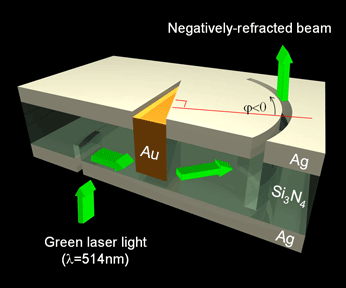|
Plasmonics (journal)
''Plasmonics'' is a bimonthly peer-reviewed scientific journal covering plasmonics, including the theory of plasmonic metamaterials, fluorescence and surface-enhanced Raman spectroscopy. It is published by Springer Science+Business Media. Its current editor is Chris D. Geddes, Director of the Institute of Fluorescence at the University of Maryland Biotechnology Institute. According to the ''Journal Citation Reports'', the journal has a 2021 impact factor of 2.726. Abstracting and indexing The journal is abstracted and indexed in: * Science Citation Index Expanded * Current Contents/Physical, Chemical & Earth Sciences * EBSCO Academic Search * EBSCO Discovery Service * EBSCO Engineering Source * EBSCO STM Source * ProQuest ProQuest LLC is an Ann Arbor, Michigan-based global information-content and technology company, founded in 1938 as University Microfilms by Eugene B. Power. ProQuest is known for its applications and information services for libraries, provid ... Advanced ... [...More Info...] [...Related Items...] OR: [Wikipedia] [Google] [Baidu] |
Plasmonics
Plasmonics or nanoplasmonics refers to the generation, detection, and manipulation of signals at optical frequencies along metal-dielectric interfaces in the nanometer scale. Inspired by photonics, plasmonics follows the trend of miniaturizing optical devices (see also nanophotonics), and finds applications in sensing, microscopy, optical communications, and bio-photonics. Principles Plasmonics typically utilizes so-called surface plasmon polaritons (SPPs), that are coherent electron oscillations travelling together with an electromagnetic wave along the interface between a dielectric (e.g. glass, air) and a metal (e.g. silver, gold). The SPP modes are strongly confined to their supporting interface, giving rise to strong light-matter interactions. In particular, the electron gas in the metal oscillates with the electro-magnetic wave. Because the moving electrons are scattered, ohmic losses in plasmonic signals are generally large, which limits the signal transfer distances to ... [...More Info...] [...Related Items...] OR: [Wikipedia] [Google] [Baidu] |
English-language Journals
English is a West Germanic language of the Indo-European language family, with its earliest forms spoken by the inhabitants of early medieval England. It is named after the Angles, one of the ancient Germanic peoples that migrated to the island of Great Britain. Existing on a dialect continuum with Scots, and then closest related to the Low Saxon and Frisian languages, English is genealogically West Germanic. However, its vocabulary is also distinctively influenced by dialects of France (about 29% of Modern English words) and Latin (also about 29%), plus some grammar and a small amount of core vocabulary influenced by Old Norse (a North Germanic language). Speakers of English are called Anglophones. The earliest forms of English, collectively known as Old English, evolved from a group of West Germanic ( Ingvaeonic) dialects brought to Great Britain by Anglo-Saxon settlers in the 5th century and further mutated by Norse-speaking Viking settlers starting in ... [...More Info...] [...Related Items...] OR: [Wikipedia] [Google] [Baidu] |
Materials Science Journals
Material is a substance or mixture of substances that constitutes an object. Materials can be pure or impure, living or non-living matter. Materials can be classified on the basis of their physical and chemical properties, or on their geological origin or biological function. Materials science is the study of materials, their properties and their applications. Raw materials can be processed in different ways to influence their properties, by purification, shaping or the introduction of other materials. New materials can be produced from raw materials by synthesis. In industry, materials are inputs to manufacturing processes to produce products or more complex materials. Historical elements Materials chart the history of humanity. The system of the three prehistoric ages ( Stone Age, Bronze Age, Iron Age) were succeeded by historical ages: steel age in the 19th century, polymer age in the middle of the following century (plastic age) and silicon age in the second half of ... [...More Info...] [...Related Items...] OR: [Wikipedia] [Google] [Baidu] |
Nanotechnology Journals
Nanotechnology, also shortened to nanotech, is the use of matter on an atomic, molecular, and supramolecular scale for industrial purposes. The earliest, widespread description of nanotechnology referred to the particular technological goal of precisely manipulating atoms and molecules for fabrication of macroscale products, also now referred to as molecular nanotechnology. A more generalized description of nanotechnology was subsequently established by the National Nanotechnology Initiative, which defined nanotechnology as the manipulation of matter with at least one dimension sized from 1 to 100 nanometers (nm). This definition reflects the fact that quantum mechanical effects are important at this quantum-realm scale, and so the definition shifted from a particular technological goal to a research category inclusive of all types of research and technologies that deal with the special properties of matter which occur below the given size threshold. It is therefore common to ... [...More Info...] [...Related Items...] OR: [Wikipedia] [Google] [Baidu] |
Optics Journals
Optics is the branch of physics that studies the behaviour and properties of light, including its interactions with matter In classical physics and general chemistry, matter is any substance that has mass and takes up space by having volume. All everyday objects that can be touched are ultimately composed of atoms, which are made up of interacting subatomic par ... and the construction of optical instruments, instruments that use or Photodetector, detect it. Optics usually describes the behaviour of visible light, visible, ultraviolet, and infrared light. Because light is an electromagnetic wave, other forms of electromagnetic radiation such as X-rays, microwaves, and radio waves exhibit similar properties. Most optical phenomena can be accounted for by using the Classical electromagnetism, classical electromagnetic description of light. Complete electromagnetic descriptions of light are, however, often difficult to apply in practice. Practical optics is usually done us ... [...More Info...] [...Related Items...] OR: [Wikipedia] [Google] [Baidu] |
Springer Science+Business Media Academic Journals
Springer or springers may refer to: Publishers * Springer Science+Business Media, aka Springer International Publishing, a worldwide publishing group founded in 1842 in Germany formerly known as Springer-Verlag. ** Springer Nature, a multinational academic publishing group created by the merger of Springer Science+Business Media, Nature Publishing Group, Palgrave Macmillan, and Macmillan Education * Axel Springer SE, an important conservative German publishing house, including several newspapers * Springer Publishing Company, an American publishing company of academic journals and books, focusing on public health and the like Places ;United States * Springer, New Mexico * Springer, Oklahoma * Springer Mountain Springer Mountain is a mountain located in the Chattahoochee National Forest on the border of Fannin and Gilmer counties. Located in the Blue Ridge Mountains in northern Georgia, the mountain has an elevation of about . Springer Mountain serves ..., southern terminus ... [...More Info...] [...Related Items...] OR: [Wikipedia] [Google] [Baidu] |
ProQuest
ProQuest LLC is an Ann Arbor, Michigan-based global information-content and technology company, founded in 1938 as University Microfilms by Eugene B. Power. ProQuest is known for its applications and information services for libraries, providing access to dissertations, theses, ebooks, newspapers, periodicals, historical collections, governmental archives, cultural archives,"Jisc and ProQuest Enable Access to Essential Digital Content" retrieved May 21, 2014 and other aggregated databases. This content was estimated to be around 125 billion digital pages, ... [...More Info...] [...Related Items...] OR: [Wikipedia] [Google] [Baidu] |
EBSCO Information Services
EBSCO Information Services, headquartered in Ipswich, Massachusetts, is a division of EBSCO Industries Inc., a private company headquartered in Birmingham, Alabama. EBSCO provides products and services to libraries of very many types around the world. Its products include EBSCONET, a complete e-resource management system, and EBSCO''host'', which supplies a fee-based online research service with 375 full-text databases, a collection of 600,000-plus ebooks, subject indexes, point-of-care medical references, and an array of historical digital archives. In 2010, EBSCO introduced its ''EBSCO Discovery Service'' (EDS) to institutions, which allows searches of a portfolio of journals and magazines. History EBSCO Information Services is a division of EBSCO Industries Inc., a company founded in 1944 by Elton Bryson Stephens Sr. and headquartered in Birmingham, Alabama. "EBSCO" is an acronym for Elton B. Stephens Company. EBSCO Industries has annual sales of about $3 billion. It is on ... [...More Info...] [...Related Items...] OR: [Wikipedia] [Google] [Baidu] |
Current Contents
''Current Contents'' is a rapid alerting service database from Clarivate Analytics, formerly the Institute for Scientific Information and Thomson Reuters. It is published online and in several different printed subject sections. History ''Current Contents'' was first published in paper format, in a single edition devoted only to biology and medicine. Other subject editions were added later. Initially, it consisted simply of a reproduction of the title pages from several hundred major peer-reviewed scientific journals, and was published weekly, with the issues containing title pages from journal issues only a few weeks previously, a shorter time lag than any service then available. There was an author index and a crude keyword subject index only. Author addresses were provided so readers could send reprint requests for copies of the actual articles. Status Still published in print, it is available as one of the databases included in Clarivate Analytics' ISI Web of Knowledge w ... [...More Info...] [...Related Items...] OR: [Wikipedia] [Google] [Baidu] |
Science Citation Index
The Science Citation Index Expanded – previously entitled Science Citation Index – is a citation index originally produced by the Institute for Scientific Information (ISI) and created by Eugene Garfield. It was officially launched in 1964 and is now owned by Clarivate (previously the Intellectual Property and Science business of Thomson Reuters). The indexing database covers more than 9,200 notable and significant journals, across 178 disciplines, from 1900 to the present. These are alternatively described as the world's leading journals of science and technology, because of a rigorous selection process. Accessibility The index is available online within Web of Science, as part of its Core Collection (there are also CD and printed editions, covering a smaller number of journals). The database allows researchers to search through over 53 million records from thousands of academic journals that were published by publishers from around the world. Chemistry Citation In ... [...More Info...] [...Related Items...] OR: [Wikipedia] [Google] [Baidu] |
Thomson Reuters
Thomson Reuters Corporation ( ) is a Canadian multinational media conglomerate. The company was founded in Toronto, Ontario, Canada, where it is headquartered at the Bay Adelaide Centre. Thomson Reuters was created by the Thomson Corporation's purchase of the British company Reuters Group in April 2008. It is majority-owned by The Woodbridge Company, a holding company for the Thomson family. History Thomson Corporation The forerunner of the Thomson company was founded by Roy Thomson in 1934 in Ontario, as the publisher of '' The Timmins Daily Press''. In 1953, Thomson acquired the '' Scotsman'' newspaper and moved to Scotland the following year. He consolidated his media position in Scotland in 1957, when he won the franchise for Scottish Television. In 1959, he bought the Kemsley Group, a purchase that eventually gave him control of the '' Sunday Times''. He separately acquired the '' Times'' in 1967. He moved into the airline business in 1965, when he acquire ... [...More Info...] [...Related Items...] OR: [Wikipedia] [Google] [Baidu] |



